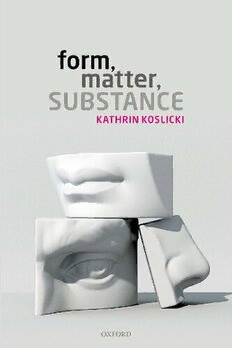Table Of ContentOUP CORRECTED PROOF – FINAL, 07/24/2018, SPi
Form, Matter, Substance
OUP CORRECTED PROOF – FINAL, 07/24/2018, SPi
OUP CORRECTED PROOF – FINAL, 07/24/2018, SPi
Form, Matter,
Substance
Kathrin Koslicki
1
OUP CORRECTED PROOF – FINAL, 07/24/2018, SPi
3
Great Clarendon Street, Oxford, OX2 6DP,
United Kingdom
Oxford University Press is a department of the University of Oxford.
It furthers the University’s objective of excellence in research, scholarship,
and education by publishing worldwide. Oxford is a registered trade mark of
Oxford University Press in the UK and in certain other countries
© Kathrin Koslicki 2018
The moral rights of the author have been asserted
First Edition published in 2018
Impression: 1
All rights reserved. No part of this publication may be reproduced, stored in
a retrieval system, or transmitted, in any form or by any means, without the
prior permission in writing of Oxford University Press, or as expressly permitted
by law, by licence or under terms agreed with the appropriate reprographics
rights organization. Enquiries concerning reproduction outside the scope of the
above should be sent to the Rights Department, Oxford University Press, at the
address above
You must not circulate this work in any other form
and you must impose this same condition on any acquirer
Published in the United States of America by Oxford University Press
198 Madison Avenue, New York, NY 10016, United States of America
British Library Cataloguing in Publication Data
Data available
Library of Congress Control Number: 2018935623
ISBN 978–0–19–882380–3
Printed and bound by
CPI Group (UK) Ltd, Croydon, CR0 4YY
Links to third party websites are provided by Oxford in good faith and
for information only. Oxford disclaims any responsibility for the materials
contained in any third party website referenced in this work.
OUP CORRECTED PROOF – FINAL, 07/24/2018, SPi
To Bob
OUP CORRECTED PROOF – FINAL, 07/24/2018, SPi
OUP CORRECTED PROOF – FINAL, 07/24/2018, SPi
Contents
Acknowledgments xi
Introduction 1
Part I. A Hylomorphic Analysis of Concrete
Particular Objects
1. Concrete Particular Objects 11
1.1 Introductory Remarks 11
1.2 Constituent vs. Non-Constituent Ontologies 11
1.3 Non-Constituent Ontologies: Platonism and Austere Nominalism 12
1.4 Constituent Ontologies: Bundle Theories and Substratum Theories 13
1.5 Difficulties for Non-Hylomorphic Competitors 15
1.6 Desiderata and Decision Points for Hylomorphists 19
1.7 Conclusion 30
2. Matter 32
2.1 Introductory Remarks 32
2.2 Matter as Prime Matter 33
2.2.1 Prime Matter in Aristotle 33
2.2.2 Thomistic Prime Matter 35
2.2.3 Difficulties for Oderberg’s Thomistic Prime Matter Hypothesis 37
2.3 Matter as Stuff 45
2.3.1 Thomistic Prime Matter as Stuff 45
2.3.2 Difficulties for Brower’s Thomistic Prime Matter as Stuff Hypothesis 48
2.3.3 Difficulties for Markosian’s Matter as Stuff Hypothesis 51
2.4 The Hylomorphic Conception of Matter 57
2.5 Conclusion 61
3. Form 62
3.1 Introductory Remarks 62
3.2 The Ontological Category of Form 63
3.2.1 Areas of Agreement and Disagreement 63
3.2.2 The Universal Forms Hypothesis 64
3.2.3 The Individual Forms Hypothesis 66
3.2.4 The Hybrid Position 71
3.3 The Individual vs. Universal Forms Debate 73
3.4 In Defense of Individual Forms 76
3.4.1 Causation, Explanation, and Change 77
3.4.2 Essence and Accident 82
3.4.3 Identity and Indiscernibility 89
3.5 Conclusion 103
OUP CORRECTED PROOF – FINAL, 07/24/2018, SPi
viii Contents
4. Hylomorphic Relations 104
4.1 Introductory Remarks 104
4.2 The Grounding Problem 105
4.3 Sidelle’s Challenge to Hylomorphists 107
4.4 Towards a Hylomorphic Solution to the Grounding Problem 109
4.4.1 The Scenario 109
4.4.2 Hylomorphic Monism 111
4.4.3 Non-Robust Hylomorphic Pluralism 112
4.4.4 Robust Hylomorphic Pluralism: A Compositional Approach 113
4.4.4.1 Robust Mereological Hylomorphic Pluralism: The Basics 114
4.4.4.2 Essential Differences between Coincident Objects 116
4.5 Explanatory Work for Non-Modal Essences 120
4.6 Conclusion 123
Part II. Substance
Introduction to Part II 125
5. Ontological Dependence 135
5.1 Preliminaries 135
5.2 Varieties of Existential Dependence 139
5.2.1 Ontological Dependence in Aristotle’s Categories 139
5.2.2 Modal Existential Dependence 142
5.2.2.1 Rigid Existential Necessary Dependence 142
5.2.2.2 Generic Existential Necessary Dependence 143
5.2.3 Other Forms of Existential Dependence 144
5.2.3.1 Necessary vs. Essential Existential Dependence 144
5.2.3.2 Rigid and Permanent Existential Dependence 146
5.2.4 Being vs. Existence 149
5.3 Varieties of Essential Dependence 150
5.3.1 Essential Identity Dependence 150
5.3.2 Constitutive Essential Dependence 154
5.3.3 Constitutive Definitional Dependence 159
5.3.4 A Potential Difficulty 160
5.4 Conclusion 162
6. Independence Criteria of Substancehood 163
6.1 Introductory Remarks 163
6.2 Substancehood 164
6.3 Independence Criteria of Substancehood 167
6.4 Alternative Strategies 171
6.4.1 Lowe’s Account 172
6.4.2 Gorman’s Modifications of Lowe’s Account 173
6.4.3 The Stipulative Exclusion of Non-Particulars 175
6.4.4 The Stipulative Exclusion of Proper Parts 176
6.4.4.1 The Possibility of Simple Substances Simpliciter 177
6.4.4.2 The Threat of Heterogeneity 177
OUP CORRECTED PROOF – FINAL, 07/24/2018, SPi
Contents ix
6.4.4.3 Proper Parts vs. Constituents 179
6.4.4.4 Intrinsicness 182
6.4.5 Matter–Form Compounds 185
6.4.5.1 Lowe’s Strategy 185
6.4.5.2 Gorman’s Exemption for Part-Dependence 186
6.4.5.3 Form as Principle of Unity 187
6.5 The Status of Forms 188
6.6 Conclusion 190
7. Unity 191
7.1 Introductory Remarks 191
7.2 Wholeness, Structure, and Unity 192
7.3 Wholeness, Integrity, and Unity 197
7.4 Ontological Dependence 206
7.5 Interactional Dependence 208
7.6 Conclusion 214
8. Artifacts 216
8.1 Introductory Remarks 216
8.2 Artifact Kinds and Natural Kinds 217
8.3 Artifact-Essences 220
8.3.1 Maker’s Intentions 220
8.3.2 Creative Acts 222
8.3.3 Functions 224
8.4 Challenges for Author-Intention-Based Accounts of Artifact-Essences 226
8.4.1 User-Intentions 227
8.4.2 Easy Ontology 230
8.4.3 Further Objections: Mass-Production and Scope 234
8.4.4 The Limits of Human Creative Intentions 235
8.5 Challenges for Existing Anti-Essentialist Frameworks 237
8.6 Conclusion 239
Conclusion 241
Bibliography 247
Index of Names 265
General Index 269

